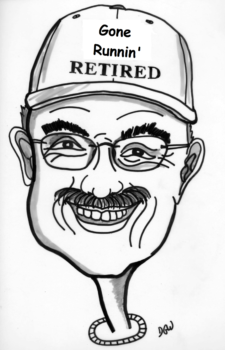If you live in the city and are preparing for a long race, you probably have found Lee Drive an ideal training spot. I’ve used the road for long training runs since 1993.
Being part of the National Parks system, commercial vehicles are prohibited, and the speed limit is 25 mph in most locations.
The route is tree-lined with broad, flat shoulders. Facing traffic, runs are safe during daylight hours.
In the fall of 1862, while Major General Burnside was stalled on Stafford and Chatham Heights trying to figure out how to cross the Rappahannock River, General Lee’s troops were digging in on Sunken Road and at the base of the ridge heading south to the rail line.
During Burnside’s indecision, Lee had time to build a supply road behind his lines from the rail line to Telegraph Road (Lafayette Blvd) with access to Sunken Road. That supply road is today’s Lee Drive.

At the far north end of the road is a path up to Lee’s Headquarters. Lee could observe both flanks and Union positions across the river from this vantage point. Parking at the bottom, the paved path is an ideal length and incline for hill workouts.
Heading south on Lee Drive, the easier climb up Bubba crests at the Howison cannon placements. Returning from the south, the upgrade is harder and longer, usually at the end of most runs.
After descending Howison Hill, the road flattens for the next two miles. Halfway to Lansdowne Road is Pickett Circle, nicknamed the “Circle of Friends.” In the early 90s, picnic tables, garbage cans, and porta pots were at the circle. Many locals hung out in their cars for many hours, not that there is anything wrong with that. Eventually, the park removed the porta pot and garbage cans.
This location is one of five where parking is permitted and is the largest. You may not park on the road edge outside of these lots. When parking in the lots, make sure not to leave valuables visible in your car. There have been issues—all the parking lots and Lee Drive south of Lansdowne Road close at sundown.
Major General Pickett stationed his troops in this area. From this location and at Lee’s Headquarters, he could observe the Union’s failed assault on Sunken Road. Not learning from history, he repeated the Union maneuver at Gettysburg seven months later with the same result.
After crossing Lansdowne Road, it is about 2.25 miles to the end of the pavement. Because there is no outlet, only tourist cars are in this section. Before 9 am, there may be 3 or 4 cars. There are a few easy-rolling hills in this section.
There are a few cannon placements at the far south end, and you can see the Meade Pyramid as you head back north to your right. The Confederate Memorial Literary Society built it in the late 1890s. This monument marks the furthest point Major General Meade’s Union troops advanced during their assault, never crossing the railroad tracks.
The road used to go past this point to Mine Road and the railroad tracks. It was closed here to reduce cut-through local traffic.
A single-track trail winds through the park if you prefer to run off-road. You can access it from the north to the west of the cannons on Howison Hill. It crosses the road, goes behind the Circle of Friends, crosses again, and comes out on Lee Drive, a half mile from Lansdowne Road. The trail starts again across from the parking lot at Lansdowne Road and stays south of Lee Drive until it terminates at the far east parking lot.
Because this is a historical rather than recreational park, the Park Service has not permitted races on Lee Drive, wishing to keep the historical nature. As long as you don’t impede traffic (run single file facing traffic), the park rangers have never had issues with walkers and runners on the road. Painting marks on the road is forbidden, and leaving staged water bottles is discouraged. Both actions interfere with the nature of the park.
In the past 15 years, they have repaved the road surface twice. The paving process takes many weeks to complete. The first step is a one to two-inch layer of loose gravel. Traffic crushes those stones into the surface with traffic, and other toppings are added. The finished surface emulates 19th-century roadways and may slow down cars and bikes with its roughness.
Blue Gray Parkway and the Virginia Central Railway Trail were unfinished when I started running on Lee Drive. The Bridge to Nowhere was complete, waiting for connector roads. Access to the industrial park was immediately south of the current Blue Gray Parkway intersection with Lafayette Boulevard.
Park access from the city was on Lafayette past the Visitor Center without worrying about crossing any busy roads. I still use this route from my house to the park. On the way south, I stay on the side of Lafayette, facing traffic, and do not use the crosswalk at Blue Gray. On the way back, I cross Lafayette at the park exit and use the crosswalk.
You can see the traffic signal from 200 meters away. I’ve learned the signal timings and traffic patterns and will speed up or slow down to reduce my wait time. One time, the city modified the pattern, which surprised me. But it’s been the same for the past ten years.
Please don’t litter in the park and enjoy the beautiful running location.
